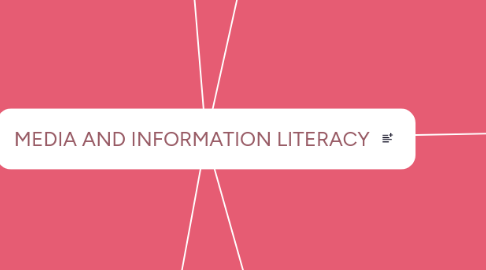
1. LESSON 4: UNDERSTANDING THE MEDIA
1.1. The Film Form
1.1.1. Film Format
1.1.2. Model of Film Production
1.1.3. Narrative
1.1.4. Documentary
1.1.5. Animation
1.1.6. Experimental
1.1.7. Film Image Composition
1.1.8. Motion Framing Concept
1.2. The TV Broadcast
1.2.1. Kinds of TV Show
1.2.2. Informative Programming
1.2.3. TV Show Anatomy and Advertising
1.3. Grafting Media Message
1.3.1. Creating Meaning in Audio Production
1.3.2. Creating Meaning in Audio Production
2. LESSON 3: UNDERSTANDING THE MEDIA
2.1. Framing and Reading
2.1.1. Photography and Timeless Image Concept
2.1.2. Newspaper and Journalism
2.2. Framing and Listening
2.2.1. Radio and Evoking Immigration
2.2.2. Books, Comics, Magazine and the Publishing Industry
3. LESSON 2: MEDIA THEN AND NOW
3.1. Brief History of Media
3.1.1. Industrial Age
3.1.2. Pre Industrial Age
3.1.3. Digital Age
3.1.4. Electronic Age
3.2. Brief History of Philippine Media
3.2.1. Pre Colonial Traces
3.2.2. The Print Industry and Filipino Freedom
3.2.3. The European Film Import
3.2.4. The Broadcast Industry
3.2.5. Local Online Media
3.3. Media Overship
3.3.1. Mainstream Media
3.3.2. Alternative and independent Media
3.3.3. Community Media
3.3.4. State Owner Media
3.4. The State of Media Today
3.4.1. From Globalization to Glocalization
3.4.2. The Local Landscape
4. LESSON 5: UNDERSTANDING MEDIA AESTHETIC MEDIA
4.1. Deconstructing New Media
4.1.1. New Media Technology
4.1.2. New Media as Multimedia
4.1.3. New Media Transition from Synergy to Transmedia
4.2. Intersecting Traditional Media and New Media
4.2.1. Podcast
4.2.2. Blogging
4.2.3. Youtube
5. LESSON 6: UNDERSTANDING MEDIA AESTHETIC OF SOCIAL MEDIA
5.1. Deeper Understanding of Social Media
5.1.1. Social Networking Site
5.1.2. What is Social Networking
5.1.3. Kinds of Social Networking
5.1.3.1. Print based
5.1.3.2. Audio based
5.1.3.3. Video based
5.1.3.4. Photo based
5.2. Relevance of Social Media
5.2.1. Business and Customer Care Tools
5.2.2. Education Tools
5.2.3. Personal Communication
5.2.4. Traditional Media Coverage
5.2.5. Entertainment Portals
5.3. The Communication Process
5.3.1. The Feedback Mechanism
5.3.2. Media as an Information Industry
5.3.3. Media as a Culture of Entertainment
6. LESSON 1: WHAT IS MEDIA?
6.1. Kinds of Media
6.1.1. Social Media
6.1.2. Traditional Media
6.1.3. New Media
6.1.4. Related and Emerging Technologies
6.1.5. Mobile Communication Technology
